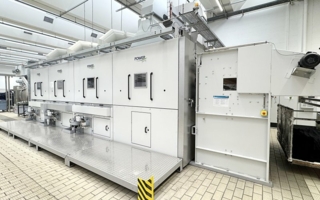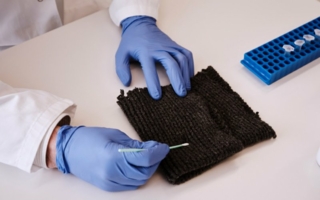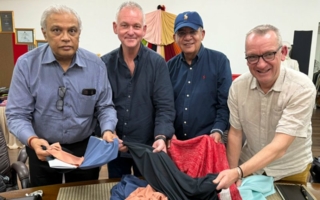10/12/2019 – Swedish machinery companies see major opportunities — auf Deutsch lesen
Heimtextil 2020 and Sweden
The decision to significantly expand its focus on textile technologies in 2020, has received an extremely enthusiastic response from members of TMAS.
“Heimtextil is already a huge show, having attracted well over 3,000 visitors to Frankfurt in January this year, filling all twelve halls of the Messe Frankfurt fair grounds,” says Secretary General Therese Premler-Andersson of the Swedish textile machinery manufacturers association TMAS. “The expansion of textile technologies at next January’s Heimtextil can only help further boost this international community of manufacturers and suppliers for the home textiles market at all levels, and naturally we want to be a part of it.”
Robotics
At Heimtextil 2019, TMAS member ACG Kinna Automatic generated a significant buzz with live demonstrations of its new robotic pillow filling system and will provide details of how it has been further developed over 2019, with several commercial systems now in place.
It has the ability to fill and finish some 3,840 pillows per eight-hour shift, which is a considerable improvement on what is currently possible with either manual or semi-automatic systems, resulting in significant savings in both labour and energy for busy home textile businesses.
“We believe many visitors to Hemitextil 2020 who saw the demonstration last year will be astonished to hear of the potential gains we are making,” says ACG Kinna CEO Christian Moore. “The use of robotics is now standard across many industries dealing in solid goods and the handling of soft materials such as textiles – while a little more complex – is next.”
ACG Kinna Automatic and its partners are at stand E24 in Hall 11 at Heimtextil 2020.
Single-pass sheeting
Meanwhile, in the first quarter of 2020, Automatex ES, the specialist in automated cutting, sewing and folding equipment, is planning to launch another innovation in advanced manufacturing for the bedding industry.
“We have developed a new fitted sheet machine which is able to sew ninety-degree corners and the elastics simultaneously, in a single operation,” explains the company’s CEO Stefan Persson. “It’s a revolution for the industry and we’re looking forward to telling visitors all about it.”
Automatex is at stand E21, also in Hall 11 at Heimtextil 2020.
Debuts
Three further TMAS members will be exhibiting for the first time at a joint stand at the show. Central to the technologies of both IRO AB and Eltex is advanced sensor technology.
IRO AB has consistently introduced new milestones in the field of yarn feeding technology for weaving machines and at Heimtextil 2020 will be providing information on new introductions to its product range.
These include the ZTF Zero Twist Feeder which keeps yarns or fibre tows constantly stretched to avoid the risks of any snarls or twisting and the ATC-W advanced tension controller for constantly regulating weft feeders at high speeds.
Eltex is achieving considerable success with its yarn fault detection and tension monitoring systems across a range of sectors, including the tufting of carpets and the creeling of woven materials, but at Heimtextil 2020 the focus will be on its advanced systems for the sewn products sector, including the UPG-Stitch thread break sensor, which is based on the piezoelectric principle and is suitable for all types of yarns while being insensitive to dust, dirt and humidity variations.
The Eltex thread sensor is meanwhile designed to monitor up to six intermittent running threads on automatic sewing machines. The eyelets are scanned electronically and it detects both broken and continuously moving threads, allowing yarn movement to be precisely monitored even at low yarn tension.
Unique bias cutting
Svegea of Sweden now has over 60 years of experience in exclusively designing, manufacturing and installing bespoke bias cutting, roll slitting and rewinding and inspection machines.
The company’s complete Bias System includes a tube sewing unit a bias cutter/winder for opening up previously-formed tube material – spirally on a bias – and strip cutter.
Circular woven materials are fed to the cutter via the revolving winder to be slit at angles, so that both the warp and weft of the weave are skewed at specified angles rather than just in the vertical and horizontal directions, as is usual.
This allows the slit fabrics to drape and form much more easily to complex shapes, with a range of potential applications in areas such as indoor and outdoor furniture, as well as bedding etc.
“The ability to produce tubular fabric which is cut on the bias allows our machine to provide textiles which not only have improved drape and elasticity properties for complex and intricate shapes, but also eliminates unnecessary wastage from the manufacturing process,” says Svegea managing director Håkan Steene. “Pre-cutting the fabric to a specific bias reduces extra handling of the fabric in further processes, saving both production time and costs. We’re looking forward to discussing the system’s potential in the home textiles market at Heimtextil 2020.”
“For visitors to Heimtextil 2020, there is much more to discover about how Swedish textile machinery innovations can help in the production of high end fabrics for the home and we extend a warm invitation to all to visit us at stand E15 in Hall 11,” Therese Premler-Andersson concludes.





